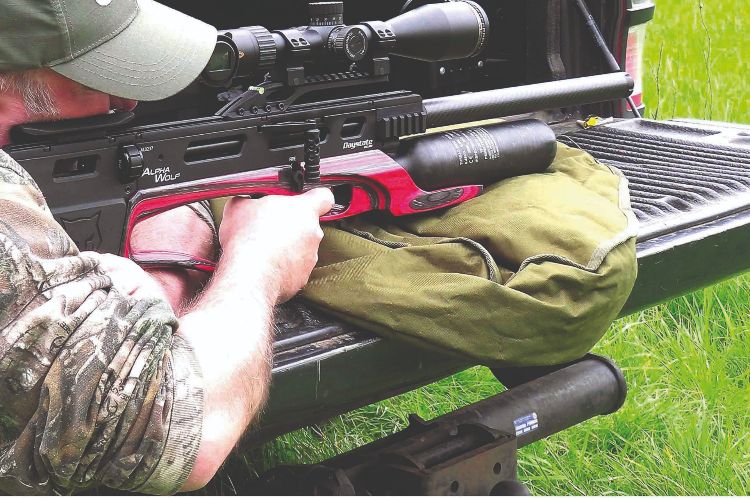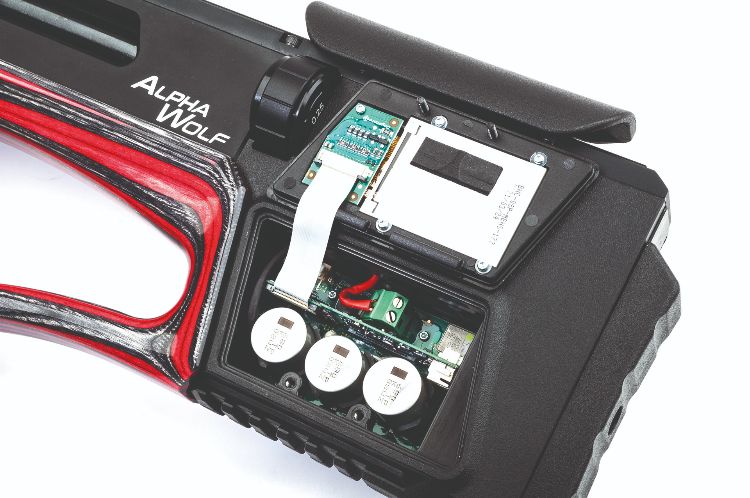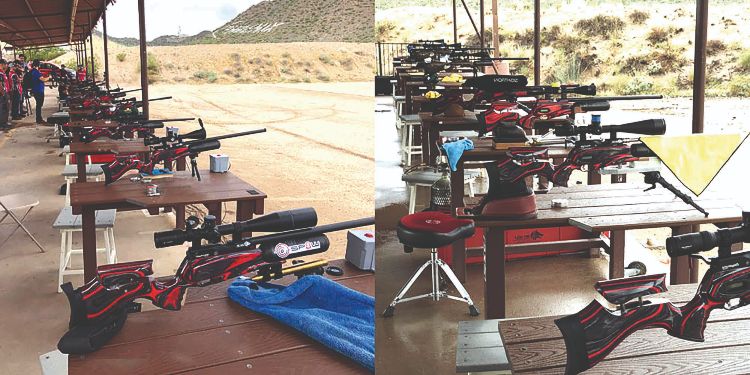I can remember back in the early ‘90s seeing a spring piston rifle called the Browning Airstar. This wonder of wonders featured a tap-loading airgun from the 1960s married to a huge battery in the fore end. When you fired the rifle, the battery kicked into life and cocked the mainspring with a whine and a clunk worthy of Caractacus Potts in Chitty Chitty Bang Bang. To help sales, the manufacturers had added a helpful price tag of around four times the price of any other top-end springer at the time. It didn't last long, and is now probably a very rare collector’s item, but it may just have set the scene that electronic airguns were coming.
FIRST FORAY
Daystate’s first foray into what was to be a long electronic journey was a series of prototypes that used an electronic trigger to compensate for the engineering losses on mechanical bullpup triggers. The further the trigger blade is away from the trigger unit itself, the less efficient the trigger can become, due to the loss of ‘feel’ caused by connecting blade to mechanism via a long, articulated link. Connecting the trigger to an electronic mechanism with a wire solves this.
Next was to be a completely electronically-fired airgun. This step came from a completely different source when Steve Harper, a freelance airgun designer, met up with David Snook, a freelance electronics engineer, on a separate project and started to talk about airguns.
PROTOTYPES EMERGE
David Snook produced within a short time a prototype of what was to become the Harper Wolf Classic PCP pistol and later the Wolf rifle. Which was available in two forms; a fully-stocked rifle and a carbine version of the pistol. Essentially, this was a long pistol with a wire stock. I use the term ‘available’ loosely as all were custom built to order, relatively expensive and largely unknown to the majority of shooters, because there was no budget to advertise or even provide enough pistols for review to get the word out there. It wasn't until Daystate made a deal with David and Steve in 2001 that any real chance of that dream of a fully electronic airgun became a reality for every shooter.
RAPID DEVELOPMENT
Daystate picked up the concept and amalgamated an existing Huntsman Mk3 project with the pretty revolutionary CDT system from the latter Harper pistols. The pace of development was rapid, from a company that once took four months to bring in a screw size change, to developing new electronics and programs almost daily. I remember the power adjustment options were thought up on a drive to a show, with the new program being ready to install on our arrival!
 TOP TEAM
TOP TEAM
Although the Mk3 rifle was new, it did have the backing of a world-leading electronics expert in the form of David Snook, along with the genius of mechanical designer, Steve Harper, and Daystate’s own highly experienced chief engineer, Rob Thompson. All three were at the top of their game and the Harper team had already eight years of electronic development under their belts.
When the Daystate Mk3 arrived on the market, though, as far as the public was concerned it was new, and ‘new’ could mean unreliable and untested. From a company that had been overly conservative until this point, the sheer innovation of the Mk3 was a hard pill to swallow. The criticism for this ground-breaking design was hard to take, especially because it usually came from many who hadn't even seen the rifle, let alone tested it! The fact was, some airgunners simply couldn’t handle even the prospect of such a change, so they decided to turn against something of which they had zero knowledge.
In many ways, this leaning toward purely mechanical designs remains, and that’s fine, of course. Mechanical watches still sell in big numbers, simply because people love mechanical designs, even though the same people are too frightened of the intricacy of the mechanism ever to look inside.
So what is inside an electronic air rifle? Let's take a look and let's start at the beginning…..
 ‘CDT’ SYSTEMS – HOW THEY WORK
‘CDT’ SYSTEMS – HOW THEY WORK
As Capacitor Discharge Technology suggests, it involves charging a capacitor to a pre-set level, then discharging it in a controlled manner into a magnetic solenoid. The armature of the solenoid is then used to strike open the valve of a pneumatic system and release a metered pulse of air. It sounds simple, there are few moving parts, and the principle is simplicity itself. However, the valve, transfer port, armature, stroke, solenoid size and actuating current waveform are heavily interlinked and needed careful design.
Back in 1994, dozens of prototype valves had to be made and tested before the design team found a formula that worked.
At that time, a new generation of transistors was emerging that made the whole technology practical, and the chief electronics designer, David Snook, spent long weekends experimenting with different pressures, timings, voltages and valve sizes trying to get the principle to work. Eventually, the CDT system was refined and was found to be extremely efficient, reliable and provided a degree of self -regulation.
MORE TO COME
As it turned out, there was more to come. The first electronic circuit developed was crude but effective. Its purpose was to charge a capacitor to a certain voltage then discharge it into the solenoid for a set period to actuate the armature and open the valve when the trigger is pressed.
The ‘lock time’, that is the time from when the trigger was pressed, to when the pellet left the barrel, was found to be incredibly short. This was found to be due to the solenoid action being able to open the valve extremely quickly, and when the current was switched off, the valve closed just as quickly, and in a controlled manner. In a conventional spring-driven, hammer-activated, knock-open valve system, there is always a degree of ‘bounce’ as the hammer overcomes the firing valve, but is resisted by the air pressure behind the valve.
Valve/hammer bounce is wasteful of air and good design can reduce it, and although it can never be completely eliminated, any mechanical system will have difficulty competing with CDT when it comes to the ‘shape’ of the air pulse.
During this initial design phase, it was surprising how short the actuating pulse of current was needed for efficient and effective valve operation. A distinct difference can be heard when dry-firing a conventional pre-charged pneumatic alongside a CDT gun. The conventional gun produces a low frequency ‘chuff’, when the CDT gun ‘cracks’. The difference is even more astounding when ammunition is used; the CDT gun is far quieter, indicating its efficiency.
Electronic control of the solenoid also gives the ability to control the power of the gun, by the use of program mapping.
In many respects it is this controllability that is the key to the system because an almost endless series of additional maps can be incorporated into the rifle, with the current Daystate Delta and Alpha Wolf including a built-in chronograph that can adjust the velocity for changes in pellet, calibre, and even just changes in power to suit different shooting scenarios.
THE DESIGN MOVES ON
By 2007 CDT had been well refined and delivered more shots per charge, and the valve was by now far more efficient because of the controlled fast-opening and closing of the firing valve. The rapid opening also allowed the pellet to accelerate quickly without waiting for a wasteful build-up of pressure. Typically, a doubling of shots was now being delivered by a well-set-up CDT rifle over the original mechanical designs, but the benefits didn’t stop there.
REAL-WORLD GAINS
Because there was less air used for a given amount of muzzle energy, there was less air blast after the pellet left the barrel. This resulted in less air turbulence and tighter groups. CDT also delivered extremely quick lock times, with magnetically fast valve-opening and quick pellet acceleration time.
Next, CDT by its nature used an electronic trigger that could be set to be super-light and responsive, yet super-safe, because applying the safety removed the current from the circuit.
Then there was the improved reliability. With fewer moving parts and little to wear out, the only thing to worry about was some routine maintenance and changing the battery.
Also, CDT rifles do not have a spring-driven hammer, so no effort is required to cock the action. This equates to virtually effort-free shooting, even in high-power modes.
The CDT system is quieter because of its efficiency and reduced air wastage. This can used to advantage when hunting and is most welcome when noise is a factor.
SECURITY AND CONTROL
As the designs matured, by 2014 CDT had a ‘bolt open’ safety where the rifle switches off when the bolt is opened and the rifle goes to standby mode if the safety catch is not applied. This setting can be adjusted from 30 seconds up to four hours in some models. The system is also more difficult to interfere with to produce illegal muzzle velocities, and the processor can be ‘locked’ to prevent unauthorised tampering.
Altering the voltage and pulse duration can be used to regulate the muzzle velocity and allow the user to select various power settings. This is where CDT gets interesting because it can be used to incorporate regulators - such as on the Delta Wolf - or to eliminate mechanical regulators altogether, such as on a Red Wolf.
 AND THEN IT CHANGED COMPLETELY…
AND THEN IT CHANGED COMPLETELY…
By 2018 Daystate reached the end of a development cycle with its original guns, but after 17 years it had a very good idea where it wanted to go next - and next was a revolutionary design called ‘Delta Wolf’.
This new rifle contained everything that all the rifles had contained up to this point, but a total redesign and repackaging meant something completely new was needed. The Delta Wolf was launched in 2020 and has now been joined this year by the Alpha Wolf. Both have a built-in chronograph, fast calibre change, fast power change, and more features that we could possibly list here.
After 20 years of progress and development, it's hard to now argue against the amazing progress of the electronic air rifle. The ‘passing fad’ is definitely here to stay!